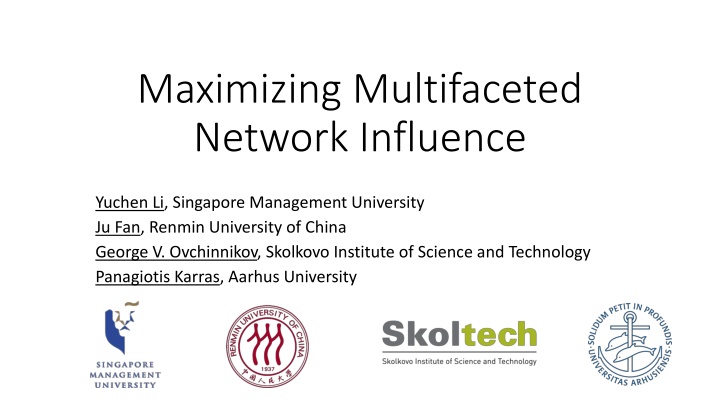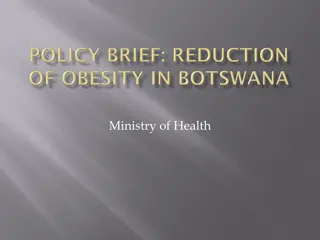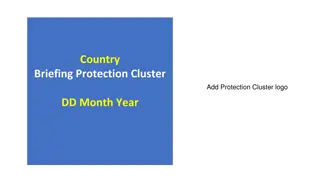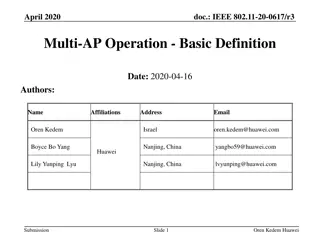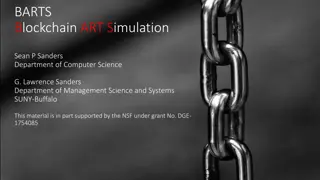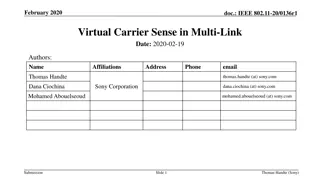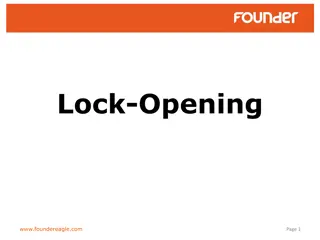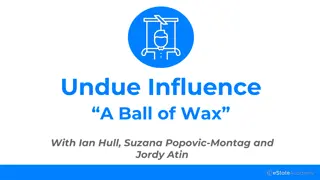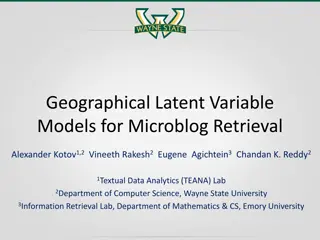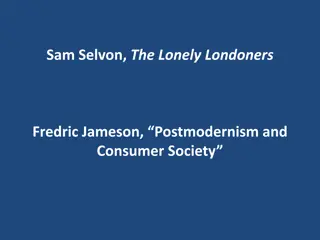Unlocking Multi-Faceted Network Influence Challenges
Exploring the complexities of social influence in maximizing network impact, addressing assumptions in influence maximization works, and real-world campaign dynamics. Delve into quantifying adoption processes with diverse messaging for enhanced influence outcomes.
Download Presentation

Please find below an Image/Link to download the presentation.
The content on the website is provided AS IS for your information and personal use only. It may not be sold, licensed, or shared on other websites without obtaining consent from the author.If you encounter any issues during the download, it is possible that the publisher has removed the file from their server.
You are allowed to download the files provided on this website for personal or commercial use, subject to the condition that they are used lawfully. All files are the property of their respective owners.
The content on the website is provided AS IS for your information and personal use only. It may not be sold, licensed, or shared on other websites without obtaining consent from the author.
E N D
Presentation Transcript
Maximizing Multifaceted Network Influence Yuchen Li, Singapore Management University Ju Fan, Renmin University of China George V. Ovchinnikov, Skolkovo Institute of Science and Technology Panagiotis Karras, Aarhus University
Background: Social Influence Social influence occurs when a person's emotions, opinions, or behaviors are affected by others Online Social Influence, e.g., Klout Applications E.g., Viral Marketing
Background: Influence Maximization (IM) Data: a directed graph ? = ?,? The IM problem: Finding k nodes in a network, such that the expected influence is maximized. 4 9 4 9 1 2 1 2 5 3 7 8 5 3 7 8 6 6 A Recent Survey: Y. Li, J. Fan, Y. Wang, and K. Tan. Influence maximization on social graphs: A survey. IEEE TKDE, 30(10):1852 1872, 2018.
Assumption of Existing IM Works Homogeneous influence network: All viral information gets the SAME influence. How about propagating multiple viral information with different topics? 4 9 4 9 4 9 1 0.2 1 1 0.8 1 0 0.3 0 0 0.1 0 1 2 1 2 1 2 1 0.9 1 Flip coin 1 1 0.7 0.9 1 1 0 0.8 0 5 3 7 8 5 3 7 8 5 3 7 8 1 0.7 1 0 0.5 0 0 0.8 0 0 0.3 0 6 6 6 Time step ?1 Time step ?2
Assumption of Existing IM Works Influence = Adoption Once a user is activated, it is considered to be influenced. How to convert users to adoption / taking meaningful action? 4 9 4 9 4 9 1 0.2 1 1 0.8 1 0 0.3 0 0 0.1 0 1 2 1 2 1 2 1 0.9 1 Flip coin 1 1 0.7 0.9 1 1 0 0.8 0 5 3 7 8 5 3 7 8 5 3 7 8 1 0.7 1 0 0.5 0 0 0.8 0 0 0.3 0 6 6 6 Time step ?1 Time step ?2
Real-World Campaigns Need to be Multi-faceted Click to LIKE vs. Click to BUY? More and non-redundant information is required for a user to buy a product. WATCH a video vs. SUBSCRIBE a channel? Watching a number of interesting and diverse videos would convert the user to a subscriber.
Multifaceted Network Influence Challenge 1: How to quantify the adoption process given multiple message pieces?
Logistic Adoption Model ? ??2 ? ? ??1 ??3 User v Adoption Utility (AU)
Maximizing Adoption with Multifaceted Network Influence Challenge 2: How to maximize adoption with multifaceted network influence? ????: Given a social network ?, a viral campaign ? containing ? viral pieces and a number k as the budget to constraint the number of seeds, the Optimal Influential Piece Assignment (OIPA) problem finds the assignment plan ? such that the plan maximizes the overall adoption utility of T over G.
Information Propagation Model Topic-Aware Independent Cascade Model Consider an example: the influence from u1 to u2 has multiple topics <0.7, 0.3, 0> A viral message is modeled as probabilistic distribution <0.2, 0.8, 0> The Influence from u1 to u2 is 0.7*0.2 + 0.3*0.8 + 0 = 0.38 Nicola Barbieri, Francesco Bonchi, Giuseppe Manco: Topic- Aware Social Influence Propagation Models. ICDM 2012: 81-90
Running Example Consider a topic-aware influence graph as below Consider two viral message pieces: t1: <1.0, 0> t2: <0, 1.0>
Strategy A Strategy B
Problem Hardness Traditional IM when one viral piece is propagated => NP hardness. A Greedy Solution can guarantee approximation ratio due to the submodular property of the objective function. However, Non-submodular objective function in multifaceted IM => Greedy solution does not guarantee approximation ratio.
Branch and Bound Framework S = { , , , } S = { ?1, , , } S = { , ?1, , } S = { , , } S = { , , , ?1} S = { ?1, ?2, , } S = { , ?1,?2, , } S = { , ?1, , ?2} S = { , ?1, , } Given any partial solution S, we compute two values: 1. Upper bound: the maximum objective value that bounds the solution space containing S. 2. Lower bound: the objective value of a plan containing S.
Technical Challenge: Bound Computation For each partial solution S, compute the maximum AU score of all possible complete plans that contain S. Non-Submodular 1 max ?? ? ?} 1 + exp{? ? ?=1 ???? ? ?=1 ? ? ??, ?? ? ?? ?? s.t. ? Reverse-Reachable (RR) Sets ? message pieces
Technical Challenge: Bound Computation tangent line For each partial solution S, update logistic function and run greedy heuristic to complete and get the upper bound value wrt. the submodular upper bound function. The plan obtained by the greedy heuristic automatically implies a lower bound on the logistic function. update a submodular upper bound over the complete the partial solution
Expensive Bound Estimation Invoke the upper bound estimation many times and each upper bound estimation is also expensive.
Progressive Bound Estimation Set a threshold h, include a user ? if the marginal value exceeds . 1+?. Non-trivial termination condition on : Near constant number of marginal value evaluations for each upper bound estimation in power law influence graphs. Theoretical guarantee on the approximation ratio. Progressive lower =
Experimental Evaluation Compared Approaches & Datasets: IM: using state-of-the-art IM solution to find a seed set S, choose the piece which S generates the largest adoption. TIM: using state-of-the-art topic-aware IM solution to find ?? for each piece ?, select ?? with the largest adoption. BAB: branch and bound framework. BAB-P: BAB with progress upper bound estimation.
We introduce a novel multifaceted network influence problem for maximizing user adoption. We show that the problem is NP-hard to approximate within any constant factor in the general setting. Conclusion We propose a branch-and-bound framework that effectively prunes search space via introducing a submodular upper bound function. We devise a progressive upper bound estimation technique to speedup the branch-and-bound framework.
Background: Influence Maximization (IM) 0.4 0.2 0.3 0.8 0.5 0.5 0.1 0.6 Finding k nodes in a network, such that the expected influence is maximized.
Assumptions of Influence Maximization Homogeneous influence network: All viral information gets the SAME influence. How about different products, different political ideas, different videos? Influence = Adoption Once a user see a viral message, it is considered to be influenced. How to convert users to adoption/take meaningful action?
